Buckwheat Flower Volatiles Attract Peristenus spretus and Enhance Its Field-Level Parasitism of Apolygus lucorum
Abstract
1. Introduction
2. Results
2.1. Behavioral Responses to Buckwheat Plants
2.2. Analysis of Buckwheat Volatiles
2.3. EAG Responses to Single Compounds
2.4. Behavioral Responses to Principal Compounds
2.5. Parasitism in the Field
3. Discussion
4. Materials and Methods
4.1. Biological and Chemical Materials
4.1.1. Insects
4.1.2. Plants
4.2. Behavioral Bioassays with Buckwheat Flowers
4.3. Collection and Analysis of Buckwheat Volatiles
4.4. EAG Recordings
4.5. Behavioral Bioassays with Synthetic Compounds
4.6. Field Trials
4.7. Statistical Analysis
5. Conclusions
Author Contributions
Funding
Data Availability Statement
Acknowledgments
Conflicts of Interest
References
- Orre Gordon, G.U.S.; Wratten, S.D.; Jonsson, M.; Simpson, M.; Hale, R. ‘Attract and reward’: Combining a herbivore-induced plant volatile with floral resource supplementation-Multitrophic level effects. Biol. Control 2013, 64, 106–115. [Google Scholar] [CrossRef]
- Cheng, Y. Study on the effect of urban space insectary plants on attracting natural enemy insects. Master’s Thesis, Beijing Forestry University, Beijing, China, 2020. [Google Scholar]
- Jonsson, M.; Wratten, S.D.; Landis, D.A.; Gurr, G.M. Recent advances in conservation biological control of arthropods by arthropods. Biol. Control 2008, 45, 172–175. [Google Scholar] [CrossRef]
- Begg, G.S.; Cook, S.M.; Dye, R.; Ferrante, M.; Franck, P.; Lavigne, C.; Lövei, G.L.; Mansion-Vaquie, A.; Pell, J.K.; Petit, S.; et al. A functional overview of conservation biological control. Crop Prot. 2017, 97, 145–158. [Google Scholar] [CrossRef]
- Sheng, Z.Y.; Li, W.Z.; Yuan, G.H. Advances in studies on the relationship between plant odor diversity and insects. Chin. J. Appl. Entomol. 2019, 56, 652–661. [Google Scholar] [CrossRef]
- Xu, H.; Turlings, T.C.J. Plant volatiles as mate-finding cues for insects. Trends Plant Sci. 2018, 23, 100–111. [Google Scholar] [CrossRef]
- Kafle, B.D.; Morawo, T.; Fadamiro, H. Host-induced plant volatiles mediate ability of the parasitoid Microplitis croceipes to discriminate between unparasitized and parasitized Heliothis virescens larvae and avoid superparasitism. J. Chem. Ecol. 2020, 46, 967–977. [Google Scholar] [CrossRef]
- Gontijo, L.; Cascone, P.; Giorgini, M.; Michelozzi, M.; Rodrigues, H.S.; Spiezia, G.; Iodice, L.; Guerrieri, E. Relative importance of host and plant semiochemicals in the foraging behavior of Trichogramma achaeae, an egg parasitoid of Tuta absoluta. J. Pest Sci. 2019, 92, 1479–1488. [Google Scholar] [CrossRef]
- Liu, F.; Lou, Y.G.; Cheng, J.A. Herbivory insect induced plant volatiles: Evolutionary products of plant-herbivore-natural enemy interactions. Entomol. Knowl. 2003, 40, 481–486. [Google Scholar]
- Su, J.W.; Cai, Z.P.; Qiao, F.; Miao, L.; Yin, S.Q.; Zheng, P.Q. Numbers of natural enemies of corn pests attracted by plant volatile lures. Chin. J. Appl. Entomol. 2020, 57, 196–205. [Google Scholar] [CrossRef]
- Xue, J.L.; He, J.; Xie, Y.P. Attractive effect of plant volatiles on Harmonia axyridis (Pallas). Chin. J. Appl. Environ. Biol. 2008, 14, 494–498. [Google Scholar]
- Liu, Y.; Guo, G.X.; Chen, J.L.; Ni, H.X. Behavioral and electrophysiological responses of four predatory insect species to semiochemicals of wheat. Acta Entomol. Sin. 2005, 48, 161–165. [Google Scholar]
- Quiroz, A.; Pettersson, J.; Pickett, J.A.; Wadhams, L.J.; Niemeyer, H.M. Semiochemicals mediating spacing behavior of bird cherry-oat aphid, Rhopalosiphum padi feeding on cereals. J. Chem. Ecol. 1997, 23, 2599–2607. [Google Scholar] [CrossRef]
- Yu, H.L.; Zhang, Y.J.; Wyckhuys, K.A.; Wu, K.M.; Gao, X.W.; Guo, Y.Y. Electrophysiological and behavioral responses of Microplitis mediator (Hymenoptera: Braconidae) to caterpillar-induced volatiles from cotton. Environ. Entomol. 2010, 39, 600–609. [Google Scholar] [CrossRef] [PubMed]
- Lu, Y.H.; Wu, K.M.; Cai, X.M.; Liu, Y.Q. A rearing method for mirids using the green bean, Phaseolus vulgaris in the laboratory. Acta Phytophylacica Sin. 2008, 35, 215–219. [Google Scholar]
- Chen, Z.C.; Su, L.; Ge, F.; Su, J.W. Electroantennogram responses of the green leaf bug, Lygus lucorum Meyer-Dür (Hemiptera: Miridae), to sex pheromone analogs and plant volatiles. Acta Entomol. Sin. 2010, 53, 47–54. [Google Scholar]
- Pan, H.S.; Lu, Y.H.; Xiu, C.L.; Geng, H.H.; Cai, X.M.; Sun, X.L.; Zhang, Y.J.; Williams, L.I.; Wyckhuys, K.A.G.; Wu, K.M. Volatile fragrances associated with flowers mediate host plant alternation of a polyphagous mirid bug. Sci. Rep. 2015, 5, 14805. [Google Scholar] [CrossRef]
- Pan, H.S.; Xiu, C.L.; Livy, W.I.; Lu, Y.H. Plant volatiles modulate seasonal dynamics between hosts of the polyphagous mirid bug Apolygus lucorum. J. Chem. Ecol. 2021, 47, 87–98. [Google Scholar] [CrossRef]
- Xiu, C.L.; Pan, H.S.; Liu, B.; Luo, Z.X.; Williams, L., III; Yang, Y.Z.; Lu, Y.H. Perception of and behavioral responses to host plant volatiles for three Adelphocoris species. J. Chem. Ecol. 2019, 45, 779–788. [Google Scholar] [CrossRef]
- Luo, S.P.; Zhang, F.; Wu, K.M. Effect of temperature on the reproductive biology of Peristenus spretus (Hymenoptera: Braconidae), a biological control agent of the plant bug Apolygus lucorum (Hemiptera: Miridae). Biocontrol Sci. Technol. 2015, 25, 1410–1425. [Google Scholar] [CrossRef]
- Luo, S.P.; Zhang, F.; Wu, K.M. Interspecific competition between Peristenus spretus and Peristenus relictus (Hymenoptera: Braconidae), larval parasitoids of Apolygus lucorum (Hemiptera: Miridae). Biol. Control 2018, 117, 115–122. [Google Scholar] [CrossRef]
- Luo, S.P.; Lu, Y.H.; Men, X.Y.; Zhang, F.; Wu, K.M. Parasitism of Apolygus lucorum by Peristenus spretus at different release levels in jujube orchards. Chin. J. Biol. Control 2016, 32, 698–702. [Google Scholar] [CrossRef]
- Colazza, S.; Peri, E.; Cusumano, A. Chemical ecology of floral resources in conservation biological control. Ann. Rev. Entomol. 2022, 68, 13–29. [Google Scholar] [CrossRef] [PubMed]
- Dai, W.J.; Pan, H.S.; Xiu, C.L.; Luo, S.P.; Yang, Y.Z.; Lu, Y.H. Behavioral selection of endoparasitoid Peristenus spretus to green mirid bug Apolygus lucorum and its damaged host plants. J. Plant Prot. 2018, 45, 194–200. [Google Scholar] [CrossRef]
- Xia, S.K.; Luo, S.P.; Li, J.Q.; Yang, Q.; Dai, C.; Yang, Y.; Lu, Y. Fructose and glucose in buckwheat nectar enhance Peristenus spretus (Hymenoptera: Braconidae) survival and parasitism of the mirid Apolygus lucorum. Biol. Control 2021, 161, 104710. [Google Scholar] [CrossRef]
- Russell, M. A meta-analysis of physiological and behavioral responses of parasitoid wasps to flowers of individual plant species. Biol. Control 2015, 82, 96–103. [Google Scholar] [CrossRef]
- Shields, M.W.; Johnson, A.C.; Pandey, S.; Cullen, R.; González- Chang, M.; Wratten, S.D.; Gurr, G.M. History, current situation and challenges for conservation biological control. Biol. Control 2019, 131, 25–35. [Google Scholar] [CrossRef]
- Li, J.H.; Liu, B.; Pan, H.S.; Luo, S.P.; Wyckhuys, K.A.G.; Yuan, H.; Lu, Y. Buckwheat strip crops increase parasitism of Apolygus lucorum in cotton. BioControl 2019, 64, 645–654. [Google Scholar] [CrossRef]
- Mohammed, K.; Agarwal, M.; Du, X.B.; Newman, J.; Ren, Y.L. Behavioural responses of the parasitoid Aphytis melinus to volatiles organic compounds (VOCs) from Aonidiella aurantii on its host fruit Tahitian lime fruit Citrus latifolia. Biol. Control 2019, 133, 103–109. [Google Scholar] [CrossRef]
- Li, M.Y.; Xia, S.K.; Zhang, T.; Williams, L.I.; Xiao, H.J.; Lu, Y.H. Volatiles from cotton plants infested by Agrotis segetum (Lep.: Noctuidae) attract the larval parasitoid Microplitis mediator (Hym.: Braconidae). Plants 2022, 11, 863. [Google Scholar] [CrossRef]
- Effah, E.; Holopainen, J.K.; McCormick, A.C. Potential roles of volatile organic compounds in plant competition. Perspect Plant Ecol. Evol. Syst. 2019, 38, 58–63. [Google Scholar] [CrossRef]
- Cai, H.H.; Zhang, T.; Su, Y.H.; Wang, Z.Y.; Zhang, X.F.; Wang, S.S.; Liu, Y.Q. Influence of trap color, type, and placement on capture efficacy for Protaetia brevitarsis (Coleoptera: Scarabaeidae). J. Econ. Entom. 2021, 114, 225–230. [Google Scholar] [CrossRef] [PubMed]
- Harvey, R.M.; Bateman, A.P.; Jain, S.; Li, Y.J.; Martin, S.; Petrucci, G.A. Optical properties of secondary organic aerosol from cis-3-hexenol and cis-3-hexenyl acetate: Effect of chemical composition, humidity, and phase. Environ. Sci. Technol. 2016, 50, 4997–5006. [Google Scholar] [CrossRef] [PubMed]
- Pragadheesh, V.S.; Yadav, A.; Chanotiya, C.S.; Rout, P.K.; Uniyal, G.C. Monitoring the emission of volatile organic compounds from flowers of Jasminum sambac using solid-phase micro-extraction fibers and gas chromatography with mass spectrometry detection. Nat. Prod. Commun. 2011, 6, 1333–1338. [Google Scholar] [CrossRef] [PubMed]
- Robertson, G.W.; Griffliths, D.W.; Woodford, J.A.T.; Birch, A.N.E. Changes in the chemical composition of volatiles released by the flowers and fruits of the red raspberry (Rubus idaeus) cultivar glen prosen. Phytochemistry 1995, 38, 1175–1179. [Google Scholar] [CrossRef]
- El-Sayed, A.M.; Mitchell, V.J.; McLaren, G.F.; Manning, L.M.; Bunn, B.; Suckling, D.M. Attraction of New Zealand flower thrips, Thrips obscuratus, to cis-jasmone, a volatile identified from Japanese honeysuckle flowers. J. Chem. Ecol. 2009, 35, 656–663. [Google Scholar] [CrossRef] [PubMed]
- Mookherjee, B.D.; Trenkle, R.W.; Wilson, R.A. Live vs. dead. Part II. A comparative analysis of the headspace volatiles of some important fragrance and flavor raw materials. J. Essent. Oil Res. 1989, 1, 85–90. [Google Scholar] [CrossRef]
- Sun, Y.L.; Dong, J.F.; Huang, L.Q.; Wang, C.Z. The cotton bollworm endoparasitoid Campoletis chlorideae is attracted by cis-jasmone or cis-3-hexenyl acetate but not by their mixtures. Arthropod-Plant Interact. 2020, 14, 169–179. [Google Scholar] [CrossRef]
- Wang, P.; Zhang, L. Olfaction in the process of herbivorous insect food selection. J. Environ. Entomol. 2021, 43, 633–641. [Google Scholar] [CrossRef]
- He, Y.Y.; Wang, K.; Zhang, Y.J.; Wu, Q.J.; Wang, S.L. Research progress of olfactory protein of parasitoid wasps. J. Environ. Entomol. 2019, 41, 1232–1243. [Google Scholar]
- Zhou, Z.; Wang, M.Q.; Hu, Y.; Chen, H.Y. Morphological structure of the antennal sensilla of Nesidiocoris tenuis observed with a scanning electron microsope. Chin. J. Appl. Entomol. 2012, 49, 631–635+635–636. [Google Scholar] [CrossRef]
- Leal, W.S.; Choo, Y.M.; Xu, P.; da Silva, C.S.; Ueira-Vieira, C. Differential expression of olfactory genes in the southern house mosquito and insights into unique odorant receptor gene isoforms. Proc. Natl. Acad. Sci. USA 2013, 110, 18704–18709. [Google Scholar] [CrossRef] [PubMed]
- Gao, X.K.; Zhang, S.; Luo, J.Y.; Wang, C.Y.; Lü, L.-M.; Zhang, L.J.; Zhu, X.Z.; Wang, L.; Cui, J.J. Molecular characterization and ligand-binding properties of six odorant-binding proteins (OBPs) from Aphis gossypii. J. Asia-Pac. Entomol. 2018, 21, 914–925. [Google Scholar] [CrossRef]
- Pan, H.S.; Liu, B.; Lu, Y.H. Host-plant switching promotes the population growth of Apolygus lucorum: Implications for laboratory rearing. Bull. Entomol. Res. 2018, 109, 309–315. [Google Scholar] [CrossRef]
- Xiu, C.L.; Dai, W.J.; Pan, H.S.; Zhang, W.; Luo, S.P.; Wyckhuys, K.A.G.; Yang, Y.Z.; Lu, Y.H. Herbivore-induced plant volatiles enhance field-level parasitism of the mirid bug Apolygus lucorum. Biol. Control 2019, 135, 41–47. [Google Scholar] [CrossRef]
- Liu, H.N.; Xiu, C.L.; Zhang, T.; Lu, Y.H. Odor perception in the cotton bollworm, Helicoverpa armigera, exposed to Juglans regia, a marginal host plant. J. Chem. Ecol. 2022, 48, 618–627. [Google Scholar] [CrossRef]
- Zhang, X.F.; Liu, H.M.; Zhang, A.H.; Fang, C.; Zhang, T. Pear leaf volatiles and their electroantennogram responses to Illiberis pruni. J. Anhui Agric. Sci. 2017, 45, 145–148. [Google Scholar] [CrossRef]

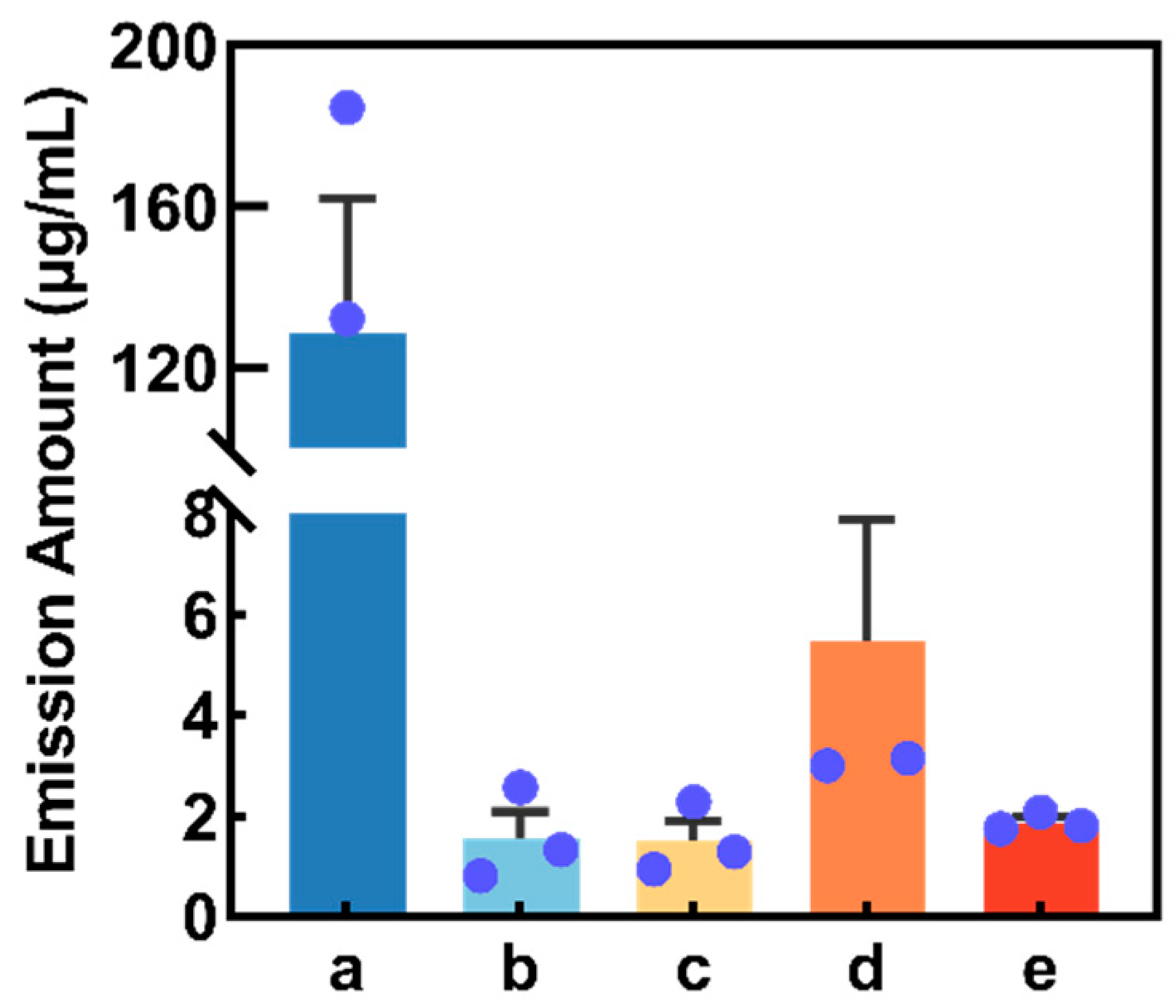
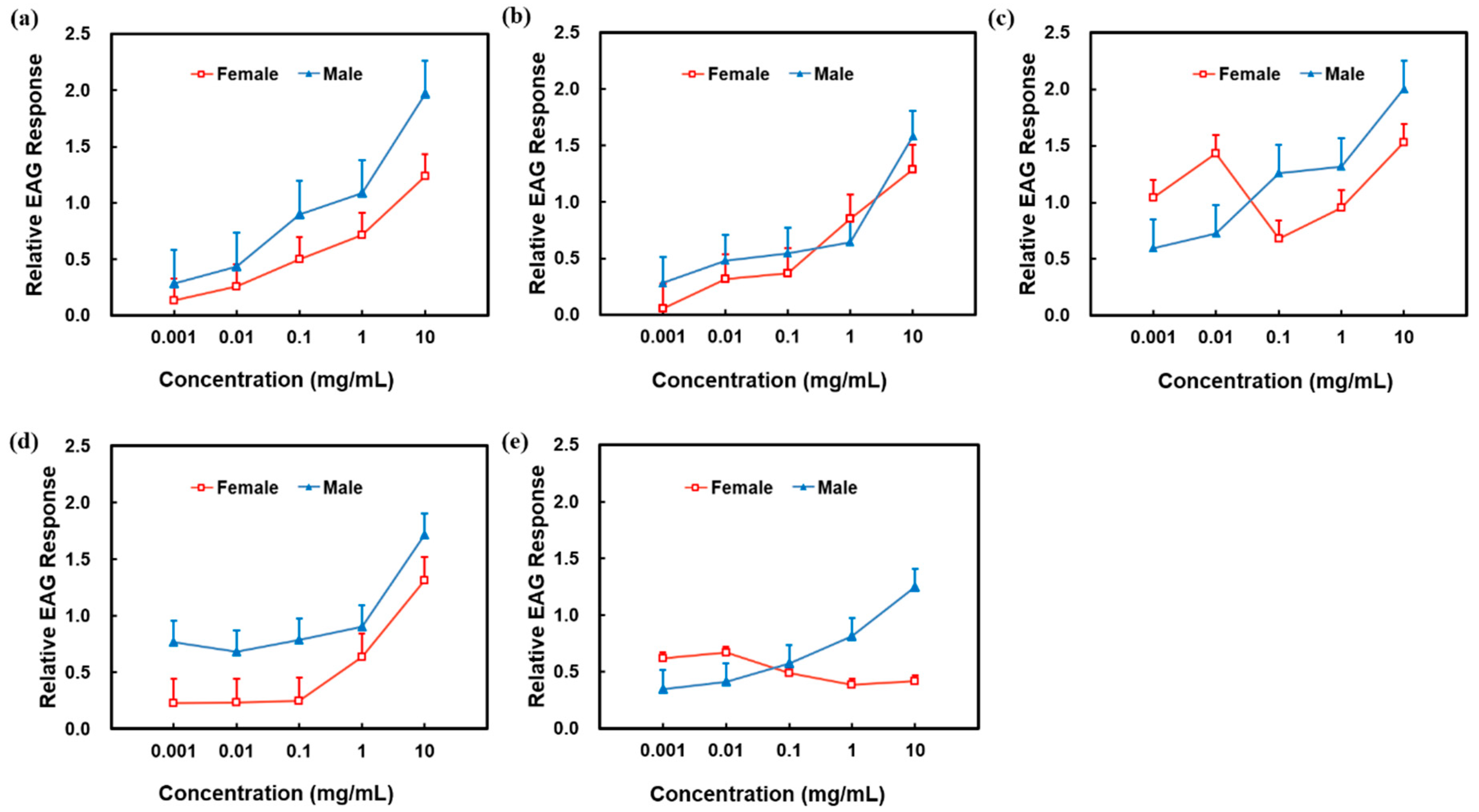
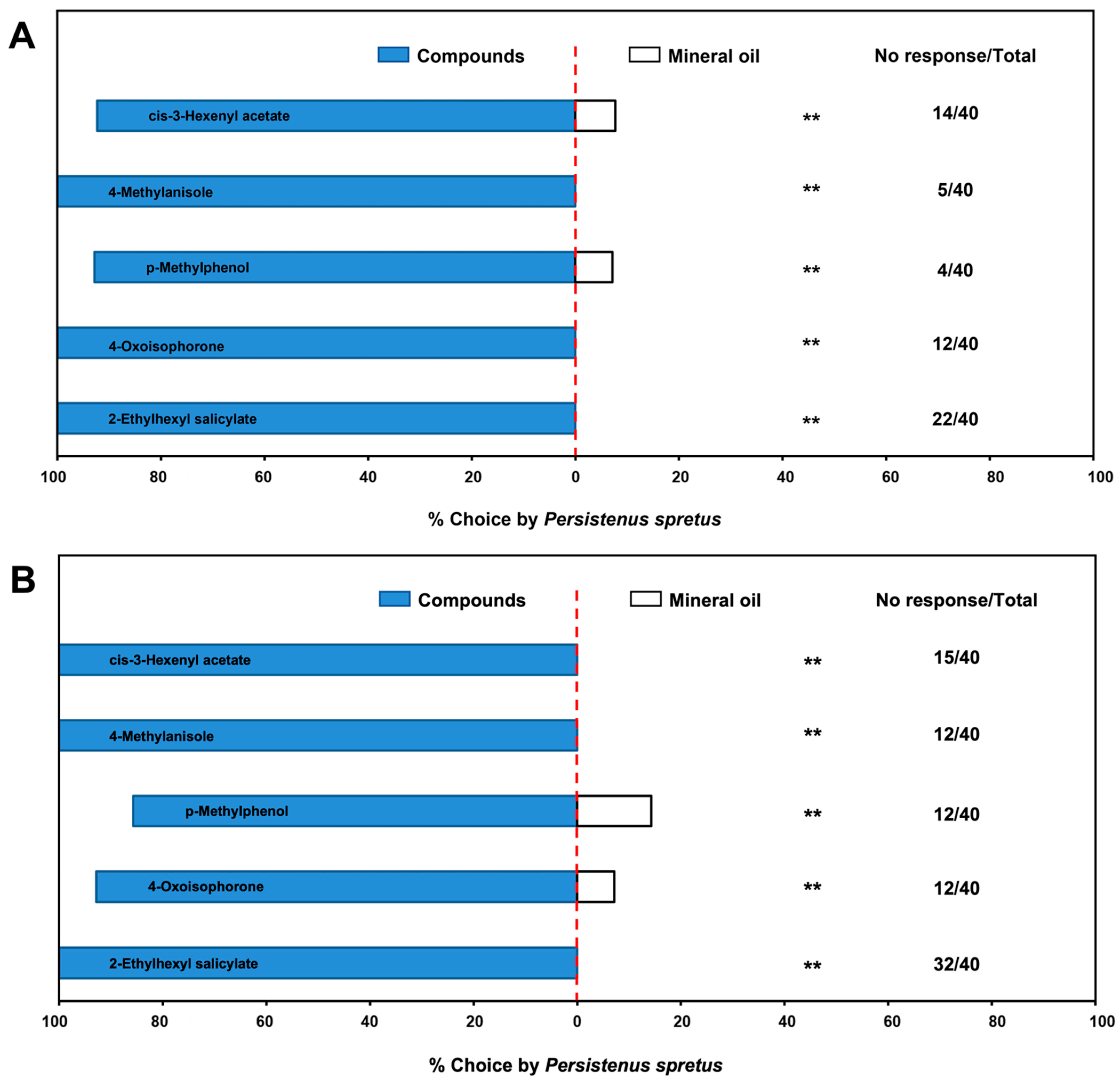
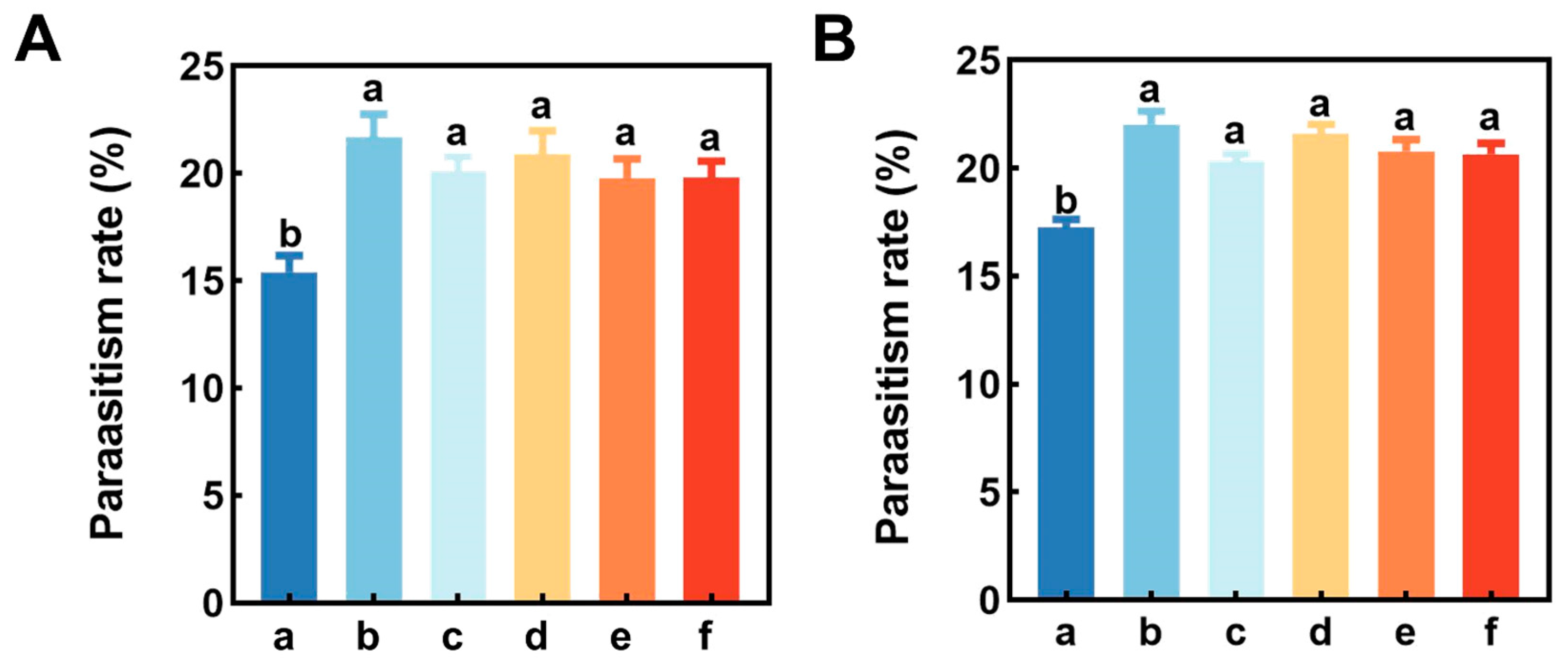
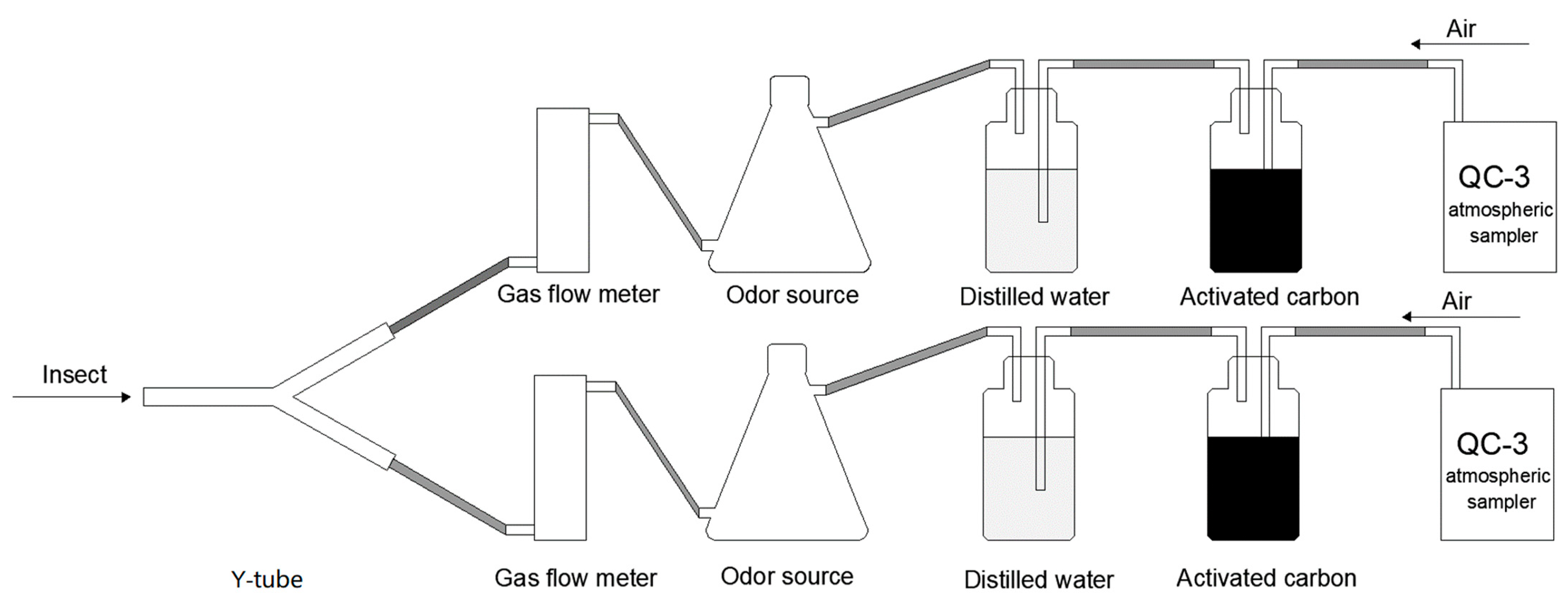
Disclaimer/Publisher’s Note: The statements, opinions and data contained in all publications are solely those of the individual author(s) and contributor(s) and not of MDPI and/or the editor(s). MDPI and/or the editor(s) disclaim responsibility for any injury to people or property resulting from any ideas, methods, instructions or products referred to in the content. |
© 2023 by the authors. Licensee MDPI, Basel, Switzerland. This article is an open access article distributed under the terms and conditions of the Creative Commons Attribution (CC BY) license (https://creativecommons.org/licenses/by/4.0/).
Share and Cite
Xia, S.; Zhang, T.; Williams, L., III; Yang, Y.; Lu, Y. Buckwheat Flower Volatiles Attract Peristenus spretus and Enhance Its Field-Level Parasitism of Apolygus lucorum. Plants 2023, 12, 1658. https://doi.org/10.3390/plants12081658
Xia S, Zhang T, Williams L III, Yang Y, Lu Y. Buckwheat Flower Volatiles Attract Peristenus spretus and Enhance Its Field-Level Parasitism of Apolygus lucorum. Plants. 2023; 12(8):1658. https://doi.org/10.3390/plants12081658
Chicago/Turabian StyleXia, Shike, Tao Zhang, Livy Williams, III, Yizhong Yang, and Yanhui Lu. 2023. "Buckwheat Flower Volatiles Attract Peristenus spretus and Enhance Its Field-Level Parasitism of Apolygus lucorum" Plants 12, no. 8: 1658. https://doi.org/10.3390/plants12081658
APA StyleXia, S., Zhang, T., Williams, L., III, Yang, Y., & Lu, Y. (2023). Buckwheat Flower Volatiles Attract Peristenus spretus and Enhance Its Field-Level Parasitism of Apolygus lucorum. Plants, 12(8), 1658. https://doi.org/10.3390/plants12081658







